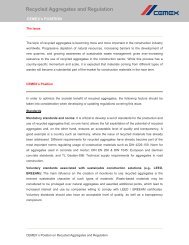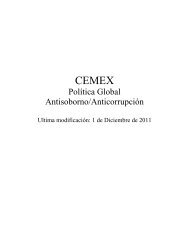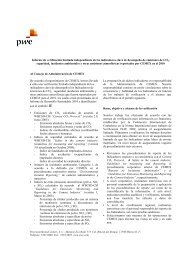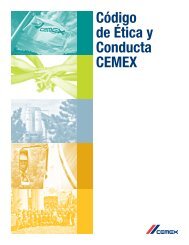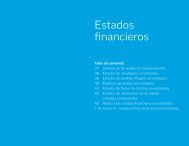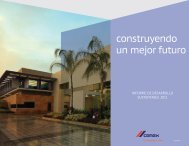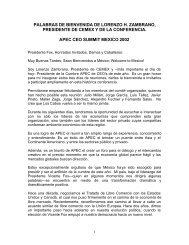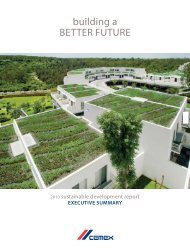building a STRONGER foundation - Cemex
building a STRONGER foundation - Cemex
building a STRONGER foundation - Cemex
Create successful ePaper yourself
Turn your PDF publications into a flip-book with our unique Google optimized e-Paper software.
To prevent, control and remediate environmental problems and maintain compliance with regulatory requirements, we maintain<br />
an environmental policy designed to monitor and control environmental matters. Our environmental policy requires each subsidiary to<br />
respect local laws and meet our own internal standards to minimize the use of non-renewable resources and the generation of<br />
hazardous and other wastes. We use processes that are designed to reduce the impact of our operations on the environment throughout<br />
all the production stages in all our operations worldwide. We believe that we are in substantial compliance with all material<br />
environmental laws applicable to us.<br />
We regularly incur capital expenditures that have an environmental component or that are impacted by environmental<br />
regulations. However, we do not keep separate accounts for such mixed capital and environmental expenditures. Environmental<br />
expenditures that extend the life, increase the capacity, improve the safety or efficiency of assets or are incurred to mitigate or prevent<br />
future environmental contamination may be capitalized. Other environmental costs are expensed when incurred. For the year ended<br />
December 31, 2007, our environmental capital expenditures were not material. For the year ended December 31, 2009 and 2010, our<br />
sustainability capital expenditures (including our environmental expenditures and investments in alternative fuels and cementitious<br />
materials) were approximately U.S.$77 million and approximately U.S.$93 million, respectively. However, our environmental<br />
expenditures may increase in the future.<br />
The following is a discussion of environmental regulations and related matters in our major markets.<br />
Mexico. We were one of the first industrial groups in Mexico to sign an agreement with the Secretaría del Medio Ambiente y<br />
Recursos Naturales, or SEMARNAT, the Mexican government’s environmental ministry, to carry out voluntary environmental audits<br />
in our 15 Mexican cement plants under a government-run program. In 2001, the Mexican environmental protection agency in charge<br />
of the voluntary environmental auditing program, the Procuraduría Federal de Protección al Ambiente, or PROFEPA, which is part<br />
of SEMARNAT, completed the audit of our 15 cement plants and awarded all our plants a Certificado de Industria Limpia, or Clean<br />
Industry Certificate, certifying that our plants are in full compliance with environmental laws. The Clean Industry Certificates are<br />
strictly renewed every two years. As of the date of this annual report, our cement plants have Clean Industry Certificates or are in the<br />
process of renewing them. We expect renewal of all currently expired Clean Industry Certificates.<br />
For over a decade, the technology for recycling used tires into an energy source has been employed in our Ensenada and<br />
Huichapan plants. By the end of 2006, all our cement plants in Mexico were using tires as an alternative fuel. Municipal collection<br />
centers in Tijuana, Mexicali, Ensenada, Mexico City, Reynosa, Nuevo Laredo and Guadalajara currently enable us to recycle an<br />
estimated 10,000 tons of tires per year. Overall, approximately 9.1% of the total fuel used in our 15 operating cement plants in Mexico<br />
during 2010 was comprised of alternative fuels.<br />
Between 1999 and April 30, 2011, our operations in Mexico have invested approximately U.S.$54.93 million in the acquisition<br />
of environmental protection equipment and the implementation of the ISO 14001 environmental management standards of the<br />
International Organization for Standardization, or ISO. The audit to obtain the renewal of the ISO 14001 certification took place<br />
during February 2010. All our operating cement plants in Mexico have obtained the renewal of the ISO 14001 certification for<br />
environmental management systems.<br />
United States. CEMEX, Inc. is subject to a wide range of U.S. Federal, state and local laws, regulations and ordinances dealing<br />
with the protection of human health and the environment. These laws are strictly enforced and can lead to significant monetary<br />
penalties for noncompliance. These laws regulate water discharges, noise, and air emissions, including dust, as well as the handling,<br />
use and disposal of hazardous and non-hazardous waste materials. These laws also create a shared liability by responsible parties for<br />
the cost of cleaning up or correcting releases to the environment of designated hazardous substances. We therefore may have to<br />
remove or mitigate the environmental effects of the disposal or release of these substances at CEMEX, Inc.’s various operating<br />
facilities or elsewhere. We believe that our current procedures and practices for handling and managing materials are generally<br />
consistent with the industry standards and legal and regulatory requirements, and that we take appropriate precautions to protect<br />
employees and others from harmful exposure to hazardous materials. See “Item 3 — Key Information — Risk Factors — Our<br />
operations are subject to environmental laws and regulations.”<br />
As of April 30, 2011, CEMEX, Inc. and its subsidiaries had accrued liabilities specifically relating to environmental matters in<br />
the aggregate amount of approximately U.S.$27.6 million. The environmental matters relate to (i) the disposal of various materials, in<br />
accordance with past industry practice, which might be categorized as hazardous substances or wastes, and (ii) the cleanup of sites<br />
used or operated by CEMEX, Inc., including discontinued operations, regarding the disposal of hazardous substances or wastes, either<br />
individually or jointly with other parties. Most of the proceedings are in the preliminary stages, and a final resolution might take<br />
several years. For purposes of recording the provision, CEMEX, Inc. considers that it is probable that a liability has been incurred and<br />
the amount of the liability is reasonably estimable, whether or not claims have been asserted, and without giving effect to any possible<br />
future recoveries. Based on information developed to date, CEMEX, Inc. does not believe it will be required to spend significant sums<br />
on these matters, in excess of the amounts previously recorded. The ultimate cost that might be incurred to resolve these<br />
environmental issues cannot be assured until all environmental studies, investigations, remediation work, and negotiations with or<br />
litigation against potential sources of recovery have been completed.<br />
69



